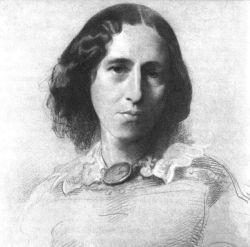Silas Marner

I hope that you managed to listen to Great Expectations, the first book of the RUSC Literary Challenge?
If you missed it, don't worry, you can read all about it right here. But, we've only got thirty days, and if we're going to get through the list of classics Joy and I put together, we'll need to move swiftly on to the next book...
International Women's Day has been observed since the early 1900's, and is celebrated on March 8th each year, so it seemed apt that as part of our literary challenge, we should include a novel written by George Eliot, which was actually the pen name of Mary Anne Evans.
During the mid nineteenth century, Mary Anne's pseudonym wrote several novels, three of which are widely acclaimed to be the greatest in the English language, Middlemarch, Daniel Deronda and the novel we have included today, Silas Marner.
Mary Anne Evans used a male pen name, to ensure that her works would be taken seriously. It wasn't that there weren't any female authors being published, as there were several, however she wanted to escape the stereotype of women only writing romances.
The novel Silas Marner certainly isn't romantic, instead focusing on treachery, and the passage of real, human emotion and relationships between family.
Set in the early nineteenth century, the novel tells the story of Silas Marner, a simple, honest and kind hearted weaver, who falls asleep one night whilst he is supposed to be watching over the seriously ill deacon of the congregation. When he wakes, he finds that the deacon has already passed away. Not only that, but the congregation's funds have been stolen whilst he was sleeping.
Falsely accused of the theft by his treacherous friend, Silas is cast out from the congregation at Lantern Yard. Having lost faith in both God and his fellow man, he heads south with his life in tatters, until he eventually settles in a small village called Raveloe. There, he lives as a recluse until his life is transformed one cold wintry night, by a little girl who he finds in his home, asleep in front of the hearth.
Silas Marner is a simple tale, and is in one sense the story of the title character, but back in the early nineteenth century, a strong sense of community was vital for emotional and material support, and so with Mary Anne Evans strong realism, it is also very much about the communities of both Lantern Yard and Raveloe in which he lives, with much of the novel's drama generated by the highly charged emotions and tension between Silas and these communities.
I'd love to know what your thoughts are about the tale of Silas Marner, so please do feel free to comment below.
Happy listening my friends,
